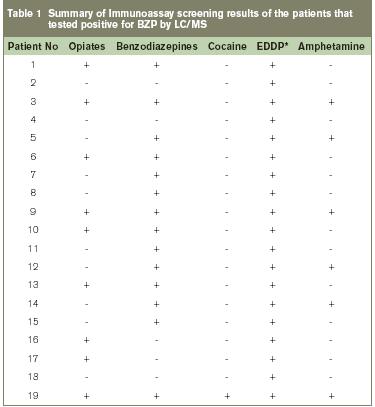Ir Med J. 2009 Jun;102(6):191.
Sir
1-Benzylpiperazine (BZP) is a member of a group of drugs known as Piperazines. It was originally synthesized as a potential antihelminthic in farm animals, however it was found to have side effects and therefore was abandoned. In the 1970s it was investigated as a potential antidepressant, but again was abandoned when it was found to have amphetamine like effects and therefore was liable to abuse.1 It is used in many countries as a legal alternative to methamphetamine and ecstasy. It has been reported that some piperazines produce mild hallucinogenic effects similar to that MDMA.2 Deaths reported as being related to BZP use to date always involved other drugs or alcohol3. However there have been reports of cases of serious toxicity from BZP use4. In July 2008, 3 adult males in Cork presented with severe reaction to BZP which required hospitalization5.
BZP has received much media attention recently and in March 2008, the European Monitoring Centre for Drugs and Drug Addiction (EMCDDA) recommended that control measures be put in place for BZP within a year6. However, until these control measures are put in place, it remains freely available in “Head” shops in Ireland and Europe. Little is currently known of the extent of the abuse of BZP.

NB: All of the immunoassay screening was performed using Cedia® kits
*EDDP – 2-ethylidene-1, 5-dimethyl-3, 3-diphenylpyrrolidine. This is the specific metabolite of methadone
A study was commenced at the Drug Treatment Centre Board’s Drug Analysis Laboratory in order to determine the level of usage of BZP amongst attendees of the Drug Treatment Centre Board (DTCB). All of the individuals tested were methadone maintenance patients. A total of 254 urine samples were initially screened by Immunoassay for Amphetamines as, in high concentrations, BZP can produce false amphetamine positive results on the Cedia® Amphetamine assay which is currently used in the DTCB Laboratory. These samples were then subjected to further analysis by LC/MS (Liquid Chromatography/ Mass Spectrometry) for BZP.
Out of 254 samples tested, 19 tested positive for BZP, 6 of which had screened positive for amphetamine by immunoassay. Therefore, 7.5% of the patients tested were positive for BZP. The age range of the individuals that tested positive for BZP was 17 to 45 years, with an average age of 31.5 years. Of the 19 tested, 10 were male and 9 were female. Table 1 shows a breakdown of the immunoassay results of the 19 patients who tested positive for BZP. Of the nineteen BZP positive patients 47% were co-abusing opiates, and 5.3% were co-abusing cocaine. 73.6% were also positive for benzodiazepines, however, many of these patients were being prescribed them. In summary, these results confirm that the abuse of BZP is high amongst this drug abusing population. It is hoped that the decision by the EMCDDA to place BZP under control may help in decreasing its usage.
S McNamara
The Drug Treatment Centre Laboratory, Trinity Court, 30-31 Pearse St., Dublin 2
Email: [email protected]
References
1. Campbell H, Cline W, Evans M, Lloyd J, Peck A. Comparison of the effects of dexamphetamine and 1-benzylpiperazine in former addicts. Eur J Clin Pharmacol 6: 170-6.
2. Baumann MH, Clark RD, Budzynski AG, Partilla JS, Blough BE, and Rothman RB. N-substituted piperazines abused by humans mimic the molecular mechanism of 3,4-methylenedioxyamphetamine (MDMA, or Ecstasy). Neuropsychopharm. 30:550-560 (2005).
3. Elliott S, Smith C. Investigation of the First Deaths in the United Kingdom Involving the Detection and Quantitation of the Piperazines BZP and 3-TFMPP. J Anal Tox. 32: 172-177(2008).
4. Wood D, Dargan PI, Button J et al. Collapse, reported seizure – and an unexpected pill. Lancet 369: 1490 (2007).
5. Roche B. Concern over the use of legal party drug. The Irish Times Health Supplement, Tuesday August 19, 2008.
6. EMCDDA. News Release from the EU drugs agency in Lisbon. Council Decision: “Appropriate Controls” for BZP. New drug BZP to be placed under control across the EU. 3rd March 2008.